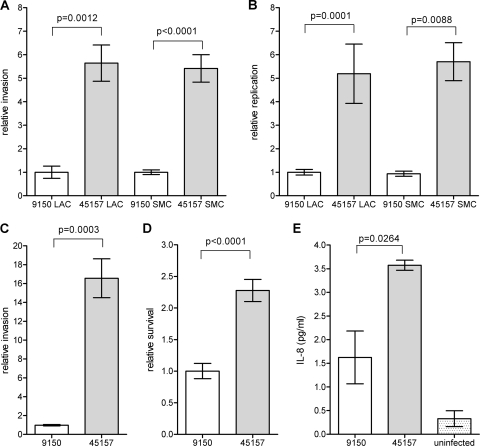Fig 4.
The outbreak strain demonstrates an increased virulence in vitro. The S. Paratyphi A reference strain ATCC 9150 and the outbreak strain (isolate 45157) were grown to either late logarithmic phase under aerobic conditions (LAC) or to a stationary phase under microaerophilic conditions (SMC) and used to infect different host cells. The invasion (A) and intracellular replication (B) of the outbreak strain in relation to the reference strain in HeLa cells are shown, following infection at a multiplicity of infection (MOI) of ∼50:1. (C) S. Paratyphi A strains that were grown to the stationary phase under microaerophilic conditions were used to infect Caco-2 cells at an MOI of ∼50:1. The invasion of the outbreak strain is shown in relation to the invasion of ATCC 9150. (D) RAW264.7 macrophage-like cells were infected with stationary-phase S. Paratyphi A strains at an MOI of ∼10:1. Survival of the outbreak strain (45157) in the macrophages 24 h postinfection, in relation to the reference strain (9150) is presented. (E) Caco-2 cells were infected with S. Paratyphi A strains grown to the stationary phase under microaerophilic conditions. The secreted IL-8 concentration was measured in the tissue culture medium 18 h postinfection using a quantitative ELISA-based chemiluminescent assay (Q-Plex human IL-8 array). Baseline levels of IL-8 were measured in uninfected cells that were included as a control (uninfected). All panels present the mean and the standard error of the mean (SEM; represented by the error bars) of at least 3 independent infections. An unpaired t test with two tails was used to determine the significance of the differences between the compared data.

